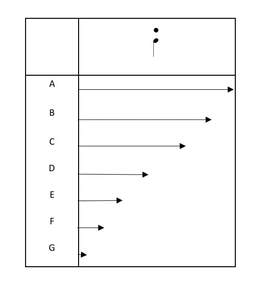|
In my classroom we define staccato as "separated." In other words, there will be a space between the staccato note and whatever comes next. How much space? Well.... Too often students develop a mental image of staccato notes as "short," or "stabbed." This frequently leads to a sound that is not characteristically appropriate. To help students conceptualize what a staccato note should sound like I will draw this diagram on the board. Assume the column's width represents a beat in 4/4, the arrows represent sound, and the music has a staccato quarter note. Which of the following would you consider to be staccato? Students will vote for the arrow(s) they think are correct. Then I will ask "which ones are separated?" Of course arrow A is not, so clearly that is not staccato. But the rest are all separated to various degrees. So according to our definition, B through G are all staccato.
Next I will ask "which one is the correct staccato?" Again, students will vote for different ones, mostly C or D. This leads to a brief discussion of what makes a particular note=length correct. Most students would say that G is too short. But it might be appropriate in a latin-jazz tune for a note with a carrot top. Some might say that B isn't separated enough. But it might be a good choice for a staccato note in a slow, lyrical passage. We discuss the various elements that contribute to making a good choice (style, tempo, etc.). The conclusion is that any one of them could be correct depending on the situation. To drive the point home I will put on a metronome at a moderately slow tempo and try to sing or play a measure of each articulation. Students experience the space between notes expanding as they listen and try to match each other. At this point they have learned to put a great deal of thought into the length of each note. Summing it Up When staccato is taught this way students learn to think about it as a musical concept rather than a rule to be followed. Students learn that when they see a staccato in their music it represents an idea that is subject to interpretation. By using this approach you will encourage your students to be thoughtful, engaged musicians.
1 Comment
|
Tips for Band TeachersPractical ideas for your elementary and middle school band class. Archives
August 2019
Categories
All
|
© Dan Halpern Music 2023 All Rights Reserved

 RSS Feed
RSS Feed